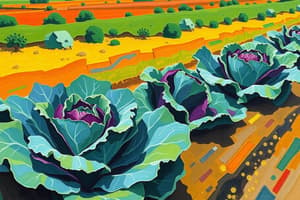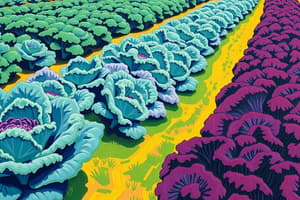Podcast
Questions and Answers
What is the primary purpose of growing a cash crop?
What is the primary purpose of growing a cash crop?
- To grow for profit and sell in the market (correct)
- To produce food for home consumption
- To produce energy for fuel
- To produce food for animal feed
What is the ideal soil pH for growing kale?
What is the ideal soil pH for growing kale?
- pH 5-6
- pH 6-7 (correct)
- pH 7-8
- pH 8-9
How long does it take for kale to mature?
How long does it take for kale to mature?
- 5-6 months (correct)
- 3-4 months
- 7-8 months
- 9-10 months
What is the purpose of strip grazing in kale production?
What is the purpose of strip grazing in kale production?
What is the recommended ratio of kale to silage/hay in a kale diet?
What is the recommended ratio of kale to silage/hay in a kale diet?
What is the name of the soil-borne fungus that can affect kale crops?
What is the name of the soil-borne fungus that can affect kale crops?
Flashcards are hidden until you start studying
Study Notes
Types of Crops
- Cash crops are grown for profit and sold in the market.
- Catch crops are fast-growing crops grown between main crops, often used for animal feed.
- Energy crops are grown for energy production, such as Miscanthus, which is processed into fuels like bioethanol or biogas.
Kale
- Kale prefers free-draining loam or sandy soil with a pH of 6-7.
- Kale is typically sown between April to July.
- Kale takes 5-6 months to mature.
- Kale is often used as a fodder crop, usually grazed in situ by cattle or sheep.
- Kale can be harvested using a zero-grazing or strip-grazing system.
Grazing Systems
- Strip grazing is a popular method, but requires suitable land to avoid poaching.
- Zero grazing involves cutting the crop and bringing it to housed animals.
Kale Nutrition
- Kale should make up 70% of an animal's diet, supplemented with 30% silage or hay.
Storage and Advantages
- Kale can be stored as bales of 'kaleage' through ensiling.
- Kale reduces winter feed and housing costs, is high in crude protein, prevents soil erosion, reduces nitrogen leaching, increases soil organic matter, and enhances biodiversity.
Disadvantages and Pest Management
- Kale is susceptible to pests and diseases, and may cause land poaching if grazed in situ.
- Club Root, a soil-borne fungus, can be controlled through crop rotation and resistant varieties.
- Flea Beetle can be controlled using contact insecticide.
Studying That Suits You
Use AI to generate personalized quizzes and flashcards to suit your learning preferences.




